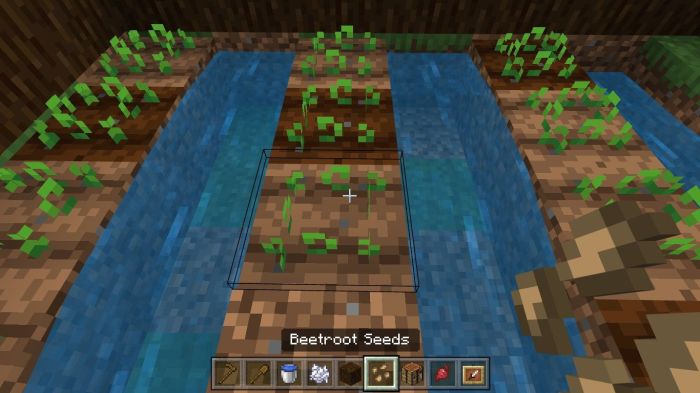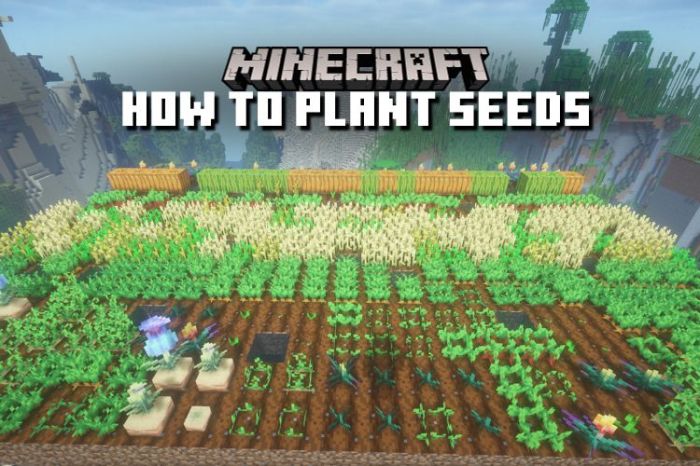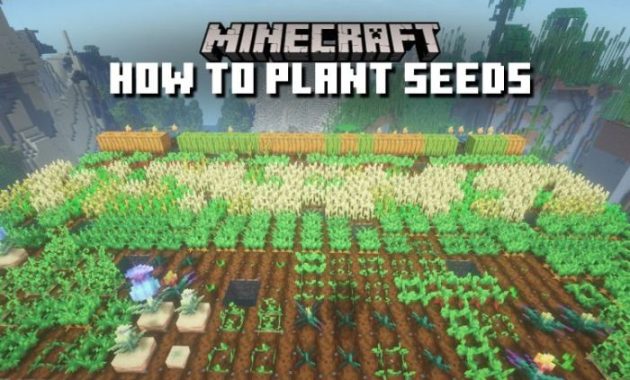Preparing the Planting Area
How to plant seeds on minecraft – The success of your Minecraft farm hinges not just on the seeds themselves, but on the meticulous preparation of the land. Think of it like choosing the perfect plot for a rice paddy in the heart of Belitung – the soil’s character dictates the harvest’s bounty. A carefully chosen and prepared planting area ensures healthy growth and a plentiful yield, transforming your humble seeds into a flourishing ecosystem.The type of soil significantly influences plant growth.
Farming directly on dirt is possible, but the results will be significantly slower than using farmland. Farmland, created by tilling dirt with a hoe, offers superior nutrient retention and moisture absorption, leading to faster growth rates. Imagine the difference between planting seedlings in dry, cracked earth versus rich, fertile soil – the latter promises a vibrant, robust harvest.
Planting seeds in Minecraft is all about finding the right spot and using the right tool. Whether you’re growing wheat for bread or massive oak trees, the process is similar. For larger plants, like trees, you might even consider more structured approaches, such as learning how to effectively plant tree in raised bed , which can be adapted to your Minecraft world.
This method ensures optimal growth and space management, just like meticulously choosing the perfect spot for your smaller Minecraft crops.
Soil Type and Plant Growth
Farmland is the ideal substrate for most crops in Minecraft. Its superior properties compared to dirt result in quicker maturation times and increased yields. The contrast is stark; a wheat seed planted in farmland will reach maturity much faster than one planted directly in dirt. This difference is akin to comparing the rapid growth of mangroves in their natural habitat to the struggle of a similar plant in infertile land.
The enhanced properties of farmland directly translate to a more efficient and productive farming operation.
Utilizing Bone Meal for Accelerated Growth
Bone meal acts as a potent fertilizer, significantly accelerating the growth rate of crops. A single application can drastically reduce the time it takes for a plant to reach maturity. Picture this: a field of sugarcane, slowly progressing towards harvest, suddenly experiencing a burst of growth after a judicious application of bone meal – it’s a transformation that mirrors the rapid development witnessed in a well-nurtured orchard.
The effect is dramatic and efficient, optimizing your farming efforts and maximizing yield. The strategic use of bone meal is akin to employing a skilled farmer’s intuition to coax the best possible results from the land.
Farm Layout Design
An efficient and visually appealing farm layout is crucial for optimal seed planting. Consider a grid pattern, ensuring easy access to each plant for harvesting and bone meal application. Imagine a perfectly aligned rice paddy, each row meticulously spaced for efficient irrigation and harvesting – this same principle applies to your Minecraft farm. A well-designed layout simplifies maintenance, harvesting, and overall farm management, turning a potentially chaotic undertaking into a streamlined and productive enterprise.
Straight lines, even spacing, and sufficient pathways are key elements of a successful farm design, mirroring the precision and planning found in successful agricultural endeavors.
Land Preparation Methods
Preparing the land involves two primary methods: tilling and clearing. Tilling, achieved using a hoe, transforms dirt into farmland, significantly improving the soil’s properties. Clearing involves removing unwanted blocks, such as trees or stone, to create a level and unobstructed planting area. Imagine clearing a dense jungle to create a perfectly level field for planting – the effort is significant, but the reward of a productive farm is well worth it.
This preparation phase is analogous to the painstaking effort of preparing the land for planting rice paddies, where the initial clearing and leveling are crucial steps towards a successful harvest.
Caring for Growing Crops

The delicate dance between seed and soil culminates in a bountiful harvest, but only with diligent care. Just as a painter needs the right light and canvas, your Minecraft crops demand the perfect conditions to thrive. Neglect, even slight, can lead to withered stalks and empty bins. This section delves into the crucial aspects of nurturing your burgeoning farm, transforming potential into plentiful yields.Proper watering and sunlight are fundamental to plant growth.
Think of it as providing the lifeblood and energy source your crops need to flourish. Without sufficient water, plants wilt and become susceptible to disease, their growth stunted and their yield diminished. Similarly, insufficient sunlight hinders photosynthesis, the process by which plants convert light into energy for growth. A well-lit, consistently watered field is the cornerstone of a successful harvest.
In Minecraft, this translates to regularly using a bucket of water on your crops and ensuring they are planted in a sunlit area. Avoid placing crops in the shade of trees or buildings.
Watering and Sunlight Requirements
Water is essential for plant growth, transporting nutrients and facilitating vital processes. Sunlight fuels photosynthesis, the engine of plant growth. The optimal balance varies depending on the crop, but generally, consistent watering and ample sunlight are key. Imagine a sunflower field – its vibrant yellow heads reaching for the sun, a testament to the power of light.
Similarly, a wilting wheat field, parched by drought, paints a stark picture of the consequences of inadequate water. In Minecraft, you can observe this effect firsthand – a lack of either will severely limit your crop yield.
Crop Protection Techniques
Protecting your crops from unwanted visitors is a crucial step in ensuring a bountiful harvest. Undesirable mobs, like zombies and creepers, can wreak havoc on your hard work, trampling and destroying your precious plants. The implementation of protective measures is essential to mitigate these risks. A simple yet effective method is the use of fences. Enclosing your farm with a fence creates a barrier, preventing hostile mobs from accessing and damaging your crops.
This simple technique significantly improves the safety and productivity of your farm. Consider it an invisible guardian, safeguarding your investment.
Disease and Infestation Prevention
Crop diseases and infestations can decimate even the most meticulously planned farm. Early detection and preventative measures are vital to safeguarding your yield. Regular inspection is paramount; identify and remove any diseased plants immediately to prevent the spread of infection. This prevents the spread of disease and reduces the chance of total crop failure. In Minecraft, while there aren’t specific diseases in the traditional sense, the presence of unwanted mobs or the lack of proper care can negatively impact crop health, mimicking the effects of disease and infestations.
Maintaining a healthy and well-cared-for farm is the best defense against these unseen threats.
Common Problems and Solutions
Several challenges can hinder crop growth. Understanding these issues and their solutions is crucial for maximizing yields.
| Problem | Solution |
|---|---|
| Insufficient sunlight | Relocate crops to a sunnier area. |
| Inadequate watering | Water crops regularly using a bucket of water. |
| Mob damage | Construct fences or walls around the farm. |
| Slow growth | Ensure sufficient sunlight and water. Use bone meal to accelerate growth. |
Advanced Farming Techniques: How To Plant Seeds On Minecraft

The initial steps of planting seeds in Minecraft might seem straightforward, but the world of efficient and automated farming opens up a whole new level of complexity and reward. Mastering these advanced techniques transforms the simple act of growing crops into a finely tuned system, capable of generating vast quantities of food and resources with minimal effort. This is where the true artistry of Minecraft farming begins.
Redstone Automation in Farming
Redstone contraptions offer a revolutionary approach to farming. Instead of manually tending to your crops, you can design sophisticated systems that automate planting, harvesting, and even bonemealing. Imagine a network of meticulously crafted redstone circuits, silently and efficiently managing your farm, freeing you to focus on other aspects of your Minecraft world. A simple example is a system using a piston to push newly grown crops into a hopper, automatically collecting the harvest.
More complex systems might incorporate water streams to transport crops, or even use observers to detect growth and trigger bone meal application. The possibilities are as vast as your imagination, and the rewards are plentiful.
Utilizing Different Farming Blocks
Farmland remains the bedrock of Minecraft agriculture, but the strategic use of other blocks significantly enhances yields. Bone meal, obtained by processing bone drops from slain skeletons, acts as a potent fertilizer, dramatically accelerating plant growth. Its judicious application can significantly reduce the time required to harvest crops. Furthermore, using different types of farmland, like those found in specific biomes, can provide unique advantages.
For instance, some biomes offer richer soil that might yield higher crop output. Understanding these nuances and combining them strategically is key to maximizing your farming potential. The careful balance of farmland, bone meal application, and potentially even modded fertilizers can transform a modest farm into a powerhouse of production.
Creating a Self-Sustaining Farm System, How to plant seeds on minecraft
A self-sustaining farm operates on a closed-loop system, minimizing external inputs while maximizing outputs. This involves integrating various elements to create a self-perpetuating cycle. For example, a system might include a villager breeder to provide a consistent source of bone meal, and a system for automatically collecting seeds from harvested crops to ensure continuous planting. This requires careful planning and implementation, but the result is a farm that runs almost entirely independently, requiring only minimal intervention.
Consider it a miniature ecosystem within your Minecraft world, a testament to your ingenuity and a source of consistent and reliable resources.
Schematic for an Efficient Automated Farm
This schematic depicts a basic automated wheat farm. Imagine a 9×9 square of farmland, surrounded by a water source to keep the land hydrated. Above each farmland block, place a hopper, connected to a chest for storage. Then, using redstone dust and comparators, create a circuit that detects when a wheat crop is ready for harvest. When a crop is ripe, a piston, activated by the redstone circuit, pushes the wheat into the hopper above.
The chest below then automatically collects the harvested wheat. A further refinement might involve a system to automatically replant the harvested seeds, using a dispenser filled with wheat seeds and activated by the same redstone circuit. This creates a fully automated wheat farm, requiring only the initial setup and occasional replenishment of seeds (if the seed collection mechanism is not perfectly efficient).
This is a foundational design; more complex systems can be built upon this framework, incorporating bone meal application, automated water management, and even automated harvesting of other crops.
Clarifying Questions
What happens if I plant seeds in the wrong type of soil?
Crops will grow more slowly, or may not grow at all, depending on the soil type. Farmland is ideal.
Can I plant seeds in any biome?
Most seeds require sufficient light and water. Some biomes may require additional preparation or support.
How do I protect my crops from mobs?
Use fences, walls, or other barriers to prevent hostile mobs from destroying your crops.
What are the best seeds to start with for a new player?
Wheat is a good starting point, as it’s easy to grow and provides valuable food.

